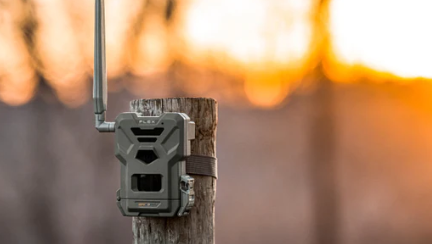Enhancing Wildlife Monitoring with Cellular Trail Cams


Cellular trail cameras have revolutionized the way hunters, wildlife enthusiasts, and property owners monitor their surroundings. Gone are the days of manually checking SD cards or physically visiting the site. With cellular trail cameras, you can receive real-time updates and images directly to your smartphone or computer, providing unparalleled convenience and efficiency.
Introduction to Cellular Trail Cameras
Cellular trail cameras are a type of game camera equipped with cellular capabilities that allow them to transmit images and data wirelessly. These cameras have become increasingly popular among outdoor enthusiasts due to their convenience and effectiveness in monitoring wildlife activity.
How Cellular Trail Cameras Work
Transmission of Images
When triggered by motion or heat, cellular trail cameras capture images or videos and send them to a designated server or cloud storage via cellular networks. Users can then access these images remotely through a mobile app or web portal.
Cellular Network Compatibility
It’s essential to choose a best value wildlife camera that is compatible with the cellular network in your area. Different cameras may support different networks, such as 4G LTE, 3G, or even 5G, so be sure to check for compatibility before making a purchase.
Benefits of Using Cellular Trail Cameras
Real-time Monitoring
One of the significant advantages of cellular trail cameras is the ability to monitor wildlife activity in real-time. Users receive instant notifications when the camera is triggered, allowing them to react promptly to any events or sightings.
Remote Accessibility
With cellular trail cameras, you can access images and data from anywhere with an internet connection. Whether you’re at home, at work, or on vacation, you can stay connected to your camera and monitor your property remotely.
Reduced Disturbance to Wildlife
Unlike traditional trail cameras that require frequent visits to retrieve data, cellular trail cameras minimize human disturbance to wildlife. By eliminating the need for physical checks, these cameras reduce stress on animals and provide more accurate data on their natural behavior.
Factors to Consider Before Purchasing a Cellular Trail Camera
Camera Resolution
When choosing a cellular trail camera, consider the resolution of the images it captures. Higher resolution cameras produce clearer and more detailed images, making it easier to identify animals and track their movements.
Battery Life
Battery life is another crucial factor to consider, especially for cameras installed in remote locations. Look for cameras with long battery life or options for external power sources to ensure uninterrupted operation.
Cellular Network Coverage
Before purchasing a cellular trail camera, verify the coverage of the cellular network in your area. Some remote locations may have limited or no coverage, which can affect the camera’s ability to transmit data effectively.
Popular Cellular Trail Camera Brands
Several brands offer high-quality cellular trail cameras, each with its unique features and capabilities. FreedomUSAsales.com has a large selection of various brands for various application including cellular and solar trail cams.
Setting Up and Using Cellular Trail Cameras
Activation Process
After purchasing a cellular trail camera, you’ll need to activate it with a cellular service provider. This typically involves registering the camera, selecting a subscription plan, and activating the SIM card included with the camera.
Mounting Options
Cellular trail cameras can be mounted in various ways, depending on the terrain and the desired monitoring area. Common mounting options include tree mounts, tripod mounts, and ground stakes, each offering different advantages in terms of stability and positioning.
Subscription Plans
Most cellular trail cameras require a subscription plan to access cellular networks and transmit data. Subscription plans vary in price and features, so choose one that best fits your budget and monitoring needs.
Tips for Maximizing Efficiency
Proper Placement
To maximize the effectiveness of your cellular trail camera, place it in areas with high wildlife activity, such as game trails, feeding areas, or water sources. Position the camera at the right height and angle to capture optimal images.
Maintenance
Regular maintenance is essential to ensure your cellular trail camera functions correctly. Clean the lens and sensors regularly, check the battery life, and inspect for any signs of damage or tampering.
Security Measures
To prevent theft or vandalism, consider using best game camera for security measures such as camouflage covers, lockable mounts, or GPS tracking devices. Additionally, choose secure locations for mounting the camera away from human traffic.
Applications of Cellular Trail Cameras
Cellular trail cameras have a wide range of applications beyond wildlife monitoring, including:
- Wildlife Monitoring: Studying animal behavior, population dynamics, and habitat use.
- Security Surveillance: Monitoring remote properties, construction sites, or unauthorized access.
- Property Management: Monitoring crops, livestock, or infrastructure on large properties or farms.
Cellular trail cameras offer a convenient and effective solution for monitoring wildlife and surveillance purposes. With real-time monitoring, remote accessibility, and minimal disturbance to wildlife, these cameras provide valuable insights into the natural world while enhancing security and property management efforts. Find the best trail camera for security.

FAQs (Frequently Asked Questions)
1. Are cellular trail cameras waterproof? Most cellular trail cameras are designed to withstand outdoor conditions, including rain and snow. However, it’s essential to check the specifications of the camera to ensure it is waterproof.
2. Do cellular trail cameras require a monthly subscription? Yes, most cellular trail cameras require a monthly subscription to access cellular networks and transmit data. Subscription plans vary in price and features, so choose one that meets your needs.
3. Can cellular trail cameras be used for security surveillance? Yes, cellular trail cameras can be used for security surveillance to monitor remote properties, construction sites, or other areas requiring surveillance.
4. How long do cellular trail camera batteries last? Battery life varies depending on the camera model, settings, and usage. Some cameras offer battery life of several months, while others may require more frequent battery changes.
5. Are cellular trail cameras legal to use for hunting? In most areas, it is legal to use cellular trail cameras for hunting purposes. However, regulations may vary by location, so be sure to check local hunting laws and regulations before using a cellular trail camera for hunting.




